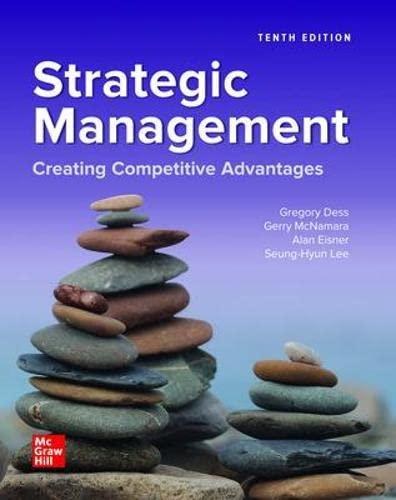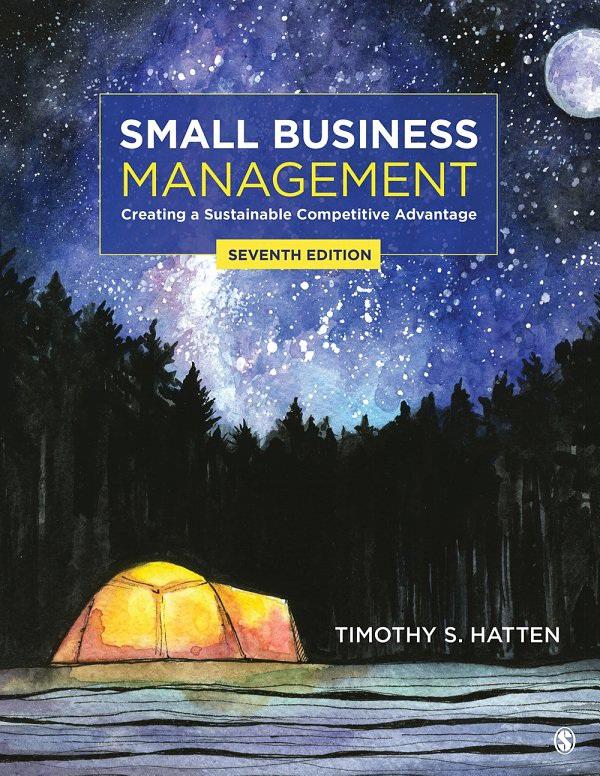Detailed Contents
1. Preface
2. Acknowledgments
3. About the Author
4. PART I: THE CHALLENGE
1. Chapter 1: Small Business: An Overview
1. Concept Module 1.1: What Is Small Business?
1. Size Definitions
2. Types of Industries
3. Microbusinesses
2. Concept Module 1.2: Small Businesses in the U.S. Economy
1. Increased Business Start-Ups
2. Increasing Interest at Colleges and Universities
3. Concept Module 1.3: Workforce Diversity and Small Business Ownership
1. The Value of Diversity to Business
4. Concept Module 1.4: Secrets of Small Business Success
1. Competitive Advantage
2. Getting Started on the Right Foot
5. Concept Module 1.5: Understanding the Risks of Small Business Ownership
1. What Is Business Failure?
2. Causes of Business Failure
3. Business Termination versus Failure
4. Mistakes Leading to Business Failure
5. Failure Rate Controversy
6. Chapter Review
2. Chapter 2: Small Business Management and Entrepreneurship
1. Concept Module 2.1: The Entrepreneur–Manager Relationship
1. What Is an Entrepreneur?
2. Entrepreneurship and the Small Business Manager
2. Concept Module 2.2: A Model of the Start-Up Process
3. Concept Module 2.3: Your Decision for Self-Employment
1. Pros and Cons of Self-Employment
2. Traits of Successful Entrepreneurs
3. Preparing Yourself for Business Ownership
4. Concept Module 2.4: Creativity and Innovation in Small Business
1. Product Innovation
2. Product Satisfaction
3. Developing New Products
4. Inventor’s Paradox
5. Importance of Product Competitive Advantage
5. Chapter Review
5. PART II: PLANNING IN SMALL BUSINESS
1. Chapter 3: Social Entrepreneurs, Ethics, and Strategic Planning
1. Concept Module 3.1: Relationship between Social Responsibility, Ethics, and Strategic Planning
2. Concept Module 3.2: Social Entrepreneurship
1. Social Responsibility
2. Economic Responsibility
3. Legal Obligations
4. Ethical Responsibility
5. Philanthropic Goodwill
3. Concept Module 3.3: Ethics and Business Strategy
1. Codes of Ethics
2. Ethics Under Pressure
4. Concept Module 3.4: Strategic Planning
1. Mission Statement
2. Environmental Analysis
3. Competitive Analysis
4. Strategic Alternatives
5. Goal Setting and Strategies
6. Control Systems
7. Strategic Planning in Action
5. Chapter Review
2. Chapter 4: The Business Plan
1. Concept Module 4.1: Every Business Needs a Plan
1. The Purpose
2. The Practice: Guidelines for Writing a Business Plan
2. Concept Module 4.2: Business Models and Feasibility Analysis
1. Feasibility Analysis
3. Concept Module 4.3: Business Plan Contents
1. Cover Page
2. Table of Contents
3. Executive Summary
4. Company Information
5. Environmental and Industry Analysis
6. Products or Services
7. Marketing Research and Evaluation
8. Manufacturing and Operations Plan
9. Management Team
10. Timeline
11. Critical Risks and Assumptions
12. Benefits to the Community
13. Exit Strategy
14. Financial Plan
15. Appendix
4. Concept Module 4.4: Review Process
1. Business Plan Mistakes
5. Concept Module 4.5: The Pitch
6. Chapter Review
6. PART III: EARLY DECISIONS
1. Chapter 5: Franchising
1. Concept Module 5.1: About Franchising
1. Background
2. Franchising Today
3. Franchising Systems
2. Concept Module 5.2: Why Open a Franchise?
1. Advantages to Franchisee
2. Disadvantages to Franchisee
3. Advantages to Franchisor
4. Disadvantages to Franchisor
3. Concept Module 5.3: Selecting a Franchise
1. Evaluate Your Needs
2. Do Your Research
3. Analyze the Market
4. Disclosure Statements
5. The Franchise Agreement
6. Get Professional Advice
4. Chapter Review
2. Chapter 6: Taking Over an Existing Business
1. Concept Module 6.1: Business-Buyout Alternative
1. Advantages of Buying a Business
2. Disadvantages of Buying a Business
2. Concept Module 6.2: How Do You Find a Business for Sale?
3. Concept Module 6.3: What Do You Look for in a Business?
1. Due Diligence
2. General Considerations
3. Why Is the Business Being Sold?
4. Financial Condition
4. Concept Module 6.4: What Are You Buying?
1. Tangible Assets
2. Intangible Assets
3. Personnel
4. The Seller’s Personal Plans
5. Concept Module 6.5: How Much Should You Pay?
1. Small Business Valuation
2. Approaches to Small Business Valuation
3. What Are the Tangible Assets Worth?
4. What Are the Intangible Assets Worth?
6. Concept Module 6.6: Buying the Business
1. Terms of Sale
2. Closing the Deal
7. Concept Module 6.7: Taking Over a Family Business
1. What Is Different about Family Businesses?
2. Complex Interrelationships
3. Planning Succession
4. General Family Business Issues
8. Chapter Review
3. Chapter 7: Starting a New Business
1. Concept Module 7.1: About Start-Ups
1. Advantages of Starting from Scratch
2. Disadvantages of Starting from Scratch
2. Concept Module 7.2: Types of New Businesses
1. Online Businesses
2. Home-Based Businesses
3. Starting a Business as a Side Gig
4. Fast-Growth Start-Ups
3. Concept Module 7.3: Evaluating Potential Start-Ups
1. Business Ideas
2. Where Business Ideas Come From
4. Concept Module 7.4: Getting Started
1. What Do You Do First?
2. Importance of Planning to a Start-Up
3. How Will You Compete?
4. Customer Service
5. Licenses, Permits, and Regulations
6. Taxes
5. Chapter Review
7. PART IV: FINANCIAL AND LEGAL MANAGEMENT
1. Chapter 8: Accounting Records and Financial Statements
1. Concept Module 8.1: Small Business Accounting
1. How Important Are Financial Records?
2. Accurate Information for Management
3. Banking and Tax Requirements
2. Concept Module 8.2: Small Business Accounting Basics
1. Double- and Single-Entry Systems
2. Accounting Equations
3. Cash and Accrual Methods of Accounting
4. What Accounting Records Do You Need?
5. Using Financial Statements to Run Your Small Business
3. Concept Module 8.3: Analyzing Financial Statements
1. Ratio Analysis
2. Using Financial Ratios
3. Liquidity Ratios
4. Asset Utilization Ratios
5. Leverage Ratios
6. Profitability Ratios
4. Concept Module 8.4: Managing Cash Flow
1. Cash Flow Defined
2. Cash Flow Fundamentals
3. Cash Flow Management Tools
4. Strategies for Cash Flow Management
5. Chapter Review
2. Chapter 9: Small Business Finance
1. Concept Module 9.1: Funding for Small Business
1. Initial Capital Requirements
2. Defining Required Assets
3. What Lenders Look For
4. Additional Considerations
2. Concept Module 9.2: Basic Financial Vocabulary
1. Forms of Capital: Debt and Equity
2. Other Loan Terminology
3. Concept Module 9.3: How Can You Find Capital?
1. Loan Application Process
2. Sources of Debt Financing
3. What If a Lender Says “No”?
4. Sources of Equity Financing
5. Choosing a Lender or Investor
4. Chapter Review
3. Chapter 10: The Legal Environment
1. Concept Module 10.1: Small Business and the Law
1. Small Business and Federal Regulations
2. Licenses, Restrictions, and Permits
2. Concept Module 10.2: Bankruptcy Laws
1. Chapter 7 Bankruptcy
2. Chapter 11 Bankruptcy
3. Chapter 13 Bankruptcy
3. Concept Module 10.3: Contract Law for Small Businesses
1. Elements of a Contract
2. Contractual Obligations
4. Concept Module 10.4: Laws to Protect Intellectual Property
1. Patents
2. Copyrights
3. Trademarks
5. Concept Module 10.5: Forms of Business Organization
1. Sole Proprietorship
2. Partnership
3. Corporation
4. Specialized Forms of Corporations
6. Chapter Review
8. PART V: MARKETING THE PRODUCT OR SERVICE
1. Chapter 11: Small Business Marketing: Strategy and Research
1. Concept Module 11.1: Small Business Marketing
1. Marketing Concept
2. Of Purple Cows
2. Concept Module 11.2: Marketing Strategies for Small Businesses
1. Setting Marketing Objectives
2. Developing a Sales Forecast
3. Building Marketing Strategies
4. Identifying Target Markets
5. Understanding Consumer Behavior
3. Concept Module 11.3: Market Research
1. Market Research Process
2. Limitations of Market Research
4. Chapter Review
2. Chapter 12: Small Business Marketing: Location
1. Concept Module 12.1: Small Business Distribution
2. Concept Module 12.2: Location for the Long Run
1. State Selection
3. Concept Module 12.3: Site Selection
1. Site Questions
2. Traffic Flow
4. Concept Module 12.4: Location Types
1. Central Business Districts
2. Shopping Centers
3. Stand-Alone Locations
4. Service Locations
5. Incubators
6. Professional Assistance
5. Concept Module 12.5: Layout and Design
1. Legal Requirements
2. Retail Layouts
3. Service Layouts
4. Manufacturing Layouts
5. Home Office
6. Concept Module 12.6: Lease, Buy, or Build?
1. Leasing
2. Purchasing
3. Building
7. Chapter Review
3. Chapter 13: Small Business Marketing: Price and Promotion
1. Concept Module 13.1: The Economics of Pricing
1. Competition
2. Customer Demand
3. Costs
2. Concept Module 13.2: Breakeven Analysis
3. Concept Module 13.3: Price-Setting Techniques
1. Customer-Oriented Pricing Strategies
2. Internal-Oriented Pricing Strategies
4. Concept Module 13.4: Getting Paid
1. Extending Credit to Your Customers
2. Collecting Overdue Accounts
5. Concept Module 13.5: Promotion
1. Advertising
2. Personal Selling
3. Public Relations
4. Sales Promotions
5. Customer Acquisition Cost
6. Promotional Mix
6. Chapter Review
9. PART VI: MANAGING SMALL BUSINESS
1. Chapter 14: Professional Small Business Management
1. Concept Module 14.1: Managing Small Business
1. Four Functions of Management
2. What Managers Do
2. Concept Module 14.2: Small Business Growth
1. Your Growing Firm
2. Transition to Professional Management
3. The Next Step: An Exit Strategy
3. Concept Module 14.3: Leadership in Action
1. Leadership Attributes
2. Negotiation
3. Delegation
4. Motivating Employees
5. Employee Theft
4. Concept Module 14.4: Special Management Concerns: Time and Stress Management
1. Time Management
2. Stress Management
5. Chapter Review
2. Chapter 15: Human Resource Management
1. Concept Module 15.1: Hiring the Right Employees
1. Job Analysis
2. Job Description
3. Job Specifications
2. Concept Module 15.2: Employee Recruitment
1. Internet Job Sites
2. Advertising for Employees
3. Employment Agencies
4. Executive Recruiters (Headhunters)
5. Employee Referrals
6. Relatives and Friends
7. Other Sources
3. Concept Module 15.3: Selecting Employees
1. Application Forms and Resumes
2. Interviewing
3. Testing
4. Hiring Independent Contractors versus Employees
4. Concept Module 15.4: Placing and Training Employees
1. Employee Training and Development
2. Ways to Train
5. Concept Module 15.5: Compensating Employees
1. Determining Wage Rates
2. Incentive-Pay Programs
3. Benefits
6. Concept Module 15.6: When Problems Arise: Employee Discipline and Termination
1. Disciplinary Measures
2. Dismissing Employees
7. Chapter Review
3. Chapter 16: Operations Management
1. Concept Module 16.1: Elements of Operating Management
1. Inputs
2. Transformation Processes
3. Outputs
4. Control Systems
5. Feedback
2. Concept Module 16.2: Operations Management
1. Operations Management for Manufacturing Businesses
2. Operations Management for Service Businesses
3. What Is Productivity?
4. Ways to Measure Manufacturing Productivity
5. Ways to Measure Service Productivity
3. Concept Module 16.3: What about Scheduling Operations?
1. Scheduling Methods
2. Routing
3. Dispatching
4. Concept Module 16.4: Quality-Centered Management
1. Six Sigma in Small Business
2. How Do You Control Operations?
5. Concept Module 16.5: Purchasing for Small Business
1. Purchasing Guidelines
2. Purchasing Basics
3. Selecting Suppliers
4. Make-or-Buy Decision
6. Concept Module 16.6: Managing Inventory
1. How Much Inventory Do You Need?
2. Costs of Carrying Inventory
3. Controlling Inventory
4. Reorder Point and Quantity
5. Visual Control
6. Economic Order Quantity
7. ABC Classification
7. Chapter Review
Glossary
11. Notes
12. Index
Preface
Are you thinking about starting your own business some day? For many students, preparation for small business ownership begins with a course in Small Business Management. My goal as an instructor (and the purpose of this text) is to help students fulfill their dreams of becoming entrepreneurs and achieving the independence that comes with small business success.
The theme of this book revolves around creating and maintaining a sustainable competitive advantage in a small business. Running a small business is difficult in today’s rapidly evolving environment. At no other time has it been so important for businesses to hold a competitive advantage. Every chapter in this book can be used to create your competitive advantage whether it be your idea, your product, your location, or your marketing plan. Running a small business is like being in a race with no finish line. You must continually strive to satisfy the changing wants and needs of your customers. This book can help you run your best race.
The writing style is personal and conversational. I have tried to avoid excessive use of jargon by explaining topics in simple, understandable language. The book is written in the first person, present tense, because I, the author, am speaking directly to you, the student. I believe that a good example can help make even the most complex concept more understandable and interesting to read. To strengthen the flow of the material and reinforce important points, examples have been carefully selected from the business press and small business owners I have known.
New to this Edition
In preparing this seventh edition, I incorporated suggestions from instructors and students who used the previous edition. In addition, an advisory board of educators from around the country was consulted to help me determine the best ways to meet the needs of students in this course. Here are some of the changes that have been made in this edition:
You know all the material that is normally called “end-of-chapter” pedagogy? I didn’t leave it at the end of the chapter questions for review, discussion, and critical thinking have been moved to the section where the content is covered. I call the approach of blocking Learning Objectives, content, examples, review, and assessment material together “Concept Modules.” I hope you like them.
Two Experiential Learning Activities have been added to each chapter to emphasize the application of what you have just learned to running a small business.
The latest information on topics critical to small business has been added. These topics include
Balance of Life for Small Business Owners
Creativity, Innovation, and Integrity in Small Business
Feasibility Studies
Lifestyle Entrepreneurs
The Gig Economy
Crowdfunding
Valuation of Small Business
Online Customer Acquisition Costs
Small Business Harvest
Risk Management in Small Business
And, of course, facets of online business, web development, social media, and mobile presence have been added in many chapters/concept modules throughout the book.
New feature boxes highlight important issues in small business management. The four types of boxed features used are Creating Competitive Advantage, Issues in Small Business, Tech in Action, and What Would You Do? In this edition, the number of boxes was reduced to avoid reader confusion, and the length of boxes was shortened to hold readers’ attention. (Believe it or not, a rumor exists that some students actually skip reading these highlight boxes. Of course, you would never do this and risk missing some of the juiciest stories.) Here is what to expect in each type of highlight box:
Creating Competitive Advantage: These real-world stories come from
streetwise business practitioners who know how it’s done and are willing to share the secrets of their success. Building a competitive advantage is the primary theme of this book.
Issues in Small Business: New to this edition, these boxes bring attention to the latest developments and topics facing small businesses.
Tech in Action: Another brand new box contains cutting-edge information on how entrepreneurs use social media and other technology to build their businesses.
What Would You Do? As part of the effort to build Concept Modules, these boxes provide students with a scenario similar to the content they are reading at that moment and are asked to describe, well, what they would do. Clever, eh?
In addition to the highlight boxes, new and revised examples, issues facing small business, and pedagogical tools that bring self-employment to life have been included all through the body of the book.
Some notable examples of small business owners (some of which have businesses that are no longer small, but they started that way):
Andrew Paradise Skillz
Alex and Andrew 4Ocean
Roni and Ken DiLullo Doggles
Jon Kourn/Brian Acton WhatsApp
Jorge Oden Wow, you HAVE to read about the device this auto mechanic created to reduce childbirth deaths in developing countries.
Don Sadoway This chemistry professor developed a radical new battery (and business) that can store power from alternative energy sources like solar and wind.
Leigh-Kathryn Bonner Bee Downtown
Daniel Katz No Cow
Topics you will find that tell the stories of small businesses include
Creating a small business start-up on campus
Building a business model
Analyzing what to do if you create a tattoo removal cream
Crowdfunding cases from Indiegogo and Kickstarter
Illuminating the path to innovation
Using big data for small businesses
Pricing with anchors, bumps, and charms
Pricing by Spotify to attract college students
Making the most of financial dashboards in the cloud
Building podcasts for your small business
Making LinkedIn your go-to place for hiring
The pedagogical features of this book are designed to complement, supplement, and reinforce material from the body of the text. The following features enhance critical thinking and show practical small business applications:
Chapter opening vignettes, Creating Competitive Advantage, and extensive use of examples throughout the book show you what real small businesses are doing.
Each chapter is broken into Concept Modules, each with its own Learning Objective that directly correlates to the topic being covered. These objectives are then revisited and summarized at the end of the chapter.
A running glossary in the margins highlights important terms as they appear in the text.
Questions for review and discussion allow you to assess your retention and comprehension at the end of Concept Modules. More questions designed to spark critical thinking prompt you to apply what you have learned to realistic situations.
Experiential Learning Activities is a new feature of this edition. These offer you the opportunity to “roll up your sleeves” and discover what it’s really like in the trenches.
Chapter Closing Cases present real-life business scenarios, allowing you to think critically about the management challenges presented and to further apply chapter concepts.
Every effort has been made to prevent “new edition bloat.” Attention has been paid to items to delete as well as what to add to stay current and streamlined. Special attention has been paid to sharpen the focus of the book to make it about “small business,” not crossing into the related but separate topic of “entrepreneurship.”
New to this Edition: Chapter by Chapter

















